View current page
...more recent posts
Justin Raimondo tries to make sense of the latest poll results on Bush's Folly:
"For the first time," a Washington Post-ABC News poll shows, "most say the Iraq war was a mistake." Not to worry, however, because "a strong majority of Americans, 58 percent, support keeping military forces in Iraq until 'civil order is restored,' even in the face of continued U.S. casualties. By a slight margin, 48 percent to 44 percent, more voters agreed with Bush's position that the United States is making 'significant progress' toward its goal of establishing democracy in Iraq." But, oh wait: "Yet, by a similar margin, the public believes the United States is not making significant progress toward restoring civil order." To top it all off, 70 percent say the present casualty rate is "unacceptable."So in the face of all this contradictory data, the New York Times sends a reporter out to "talk to America" and sums up the findings in this (online) headline today:
Fighting On Is the Only Option, Americans Say"Fighting on"--what a crock. It's Vietnam all over again. Growing up, I remember well the mantra "We can't pull out of South Vietnam, there will be a bloodbath." Meaning civil war and reprisals, but as it turned out the bloodbath in Vietnam was the one we caused by staying and bombing and defoliating year after year. Iraq is even worse, though, because we out-and-out invaded it. As Raimondo reminds us:
Having bombed the nation's physical and social infrastructure into piles of blood-stained rubble, disbanded the Iraqi military, marginalized the highly educated and secularized Sunni elite and driven them into a destructive and increasingly successful insurgency – we can't leave until we establish the "civil order" destroyed by ourselves to begin with.The "only option" is to pull out our troops and offer financial reparations (and help to refugees) for the havoc we caused. Then impeach Bush for ginning up the phony WMD threat. We're the 800 pound gorilla, we can do whatever we want. Last I heard there was no other global superpower around to "interpret this as a sign of weakness." Terrorism is the price we pay for maintaining 700 military bases around the world after the cold war ended.
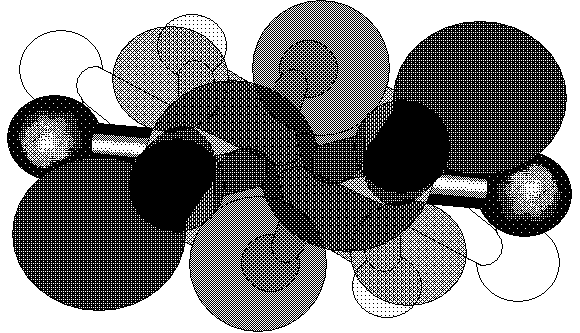
For any bloggers having comment spam problems, there are links at this post addressing some of the issues, particularly with blogs running Movable Type. In a nutshell, comment spam is an unscrupulous use of the blogger's comment feature, where a robot leaves URLs to drive up traffic for certain crapola sites, or create artificial traffic, or whatever. A big source of the problem is compromised Windows machines that act as slavebots to send out the spam. Meaning some popup trojan could have gotten into your PC, causing your computer to send out spam without your knowledge while you're websurfing. The real villain here is Bill Gates--it all goes back to Microsoft's slimy tactics during their antitrust suit where they argued that Internet Explorer was an integral part of their operating system and not some detachable, independently competitive feature. By actually integrating the two things, they made everyone's PCs much more vulnerable to hackers. Way to go, Microsoft!
Time Magazine's Person of the Year.
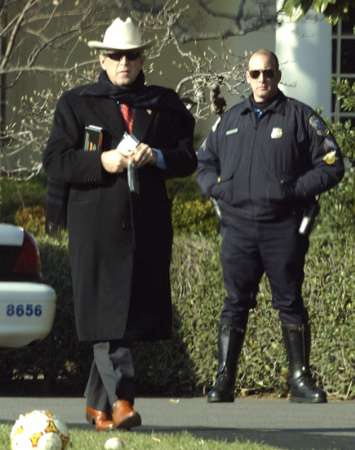
Some scary shit found on Digby's site, with lyrics to match ("We doin' big pimpin, we spendin' cheese / We doin' big pimpin' up in DC"). I've been trying to have a moratorium on Bush images because I think even the satirical ones just add to his cult, but this one belongs in the horror hall of fame. The American Ghaddafi? Russian mobster? A friend says he looks awfully prissy for a cowboy.
TOM MOODY WEBLOG TOP TEN 2004
1. Site Specific Art is Dead; Long Live.... According to this text from the year 2035, the dinosaur finally died when artists ran amok in the Saarinen airport terminal; meanwhile, the small mammals of wireless and GPS-based art stirred at Spectropolis 2004 and the psy.geo.CONFLUX.
2. Diana Kingsley at Leo Castelli. This artist's subtle humor has been evading the New York art world for years. The New Yorker is the latest not to get it.
3. Ross Knight at the Sculpture Center. More art too subtle for Saltz and the pros.
4. The Infinite Fill Show at Foxy Production. Disclosure: yrs truly was in this show (along with 92 other artists).
5. Four-way tie: Banks Violette at Team, John Parker at Front Room, Joe McKay at vertexList, Paper Rad at Foxy Production (and online).
6. Loretta Lux. Powerful images of ideal children combine painting, photography and digi-manipulation, made even more meme-worthy by resizing at a web-friendly 300 x 300 pixels.
7. Chris Ashley, Jan - December 2004. Abstract painter moves to web, uses your browser to make paintings, blows away competition.
8. SCREENFULL, July - December 2004. If Sigmar Polke were in his 20s today and/or Richard Prince surfed the net instead of painting, this is what they'd be doing. If only it could be commodified...
9. Michelle Handelman in Bryant Park. The performances were memorably quirky, the summer day was beautiful, Bryant Park was beautiful...
10. Duncan Hannah at JG Contemporary/James Graham & Sons. Weirdly affectless Hopperesque work by one of New York's best painters, whose work has long been too subtle for...oh never mind.
Honorable Mention: The art world's efforts to end the Iraq War and throw the current bums out of office, even though both have so far failed.
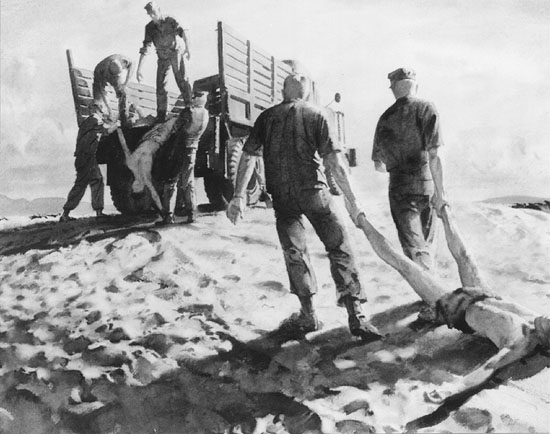
1965 watercolors by Gene Klebe. Above: Clean-Up After Marble Mountain Battle; below: Operation Market Time.
Art worlders, including many in the blogosphere, continue to give salutatory high-fives each time a new series of drawings appears by Steve Mumford, an artist who has been unironically embedded with the troops in Iraq. Carol Kino did it in the New York Times as well, this week. This page has complained (here and later here) that Mumford's a rather ham fisted draftsman and absolutely on the wrong side of the war issue. Bush has a snit because Saddam tried to kill his Daddy, the neocons seek a permanent American "footprint" in the mideast, thousands upon thousands needlessly die from American bombing and the subsequent chaos, and there's Mumford sanitizing the mess. The art world marched to stop this horror but out of friendship (or simple bewilderment) enables Mumford to do his thing.
Commenter Mr. Potts likes Mumford's work, and steers us toward this Dept. of the Navy page of sketches and paintings from the Vietnam era. (The pictures in this post come from there.) These are indeed Mumford's forerunners: official, clunky court room style art that supports the war effort--except the two images here, by Gene Klebe, actually have more punch and clarity than Mumford's washy drawings. But the art world wouldn't fete the artists on the Navy's site and give them shows at White Columns. They'd be seen as "mere illustrators" who wouldn't get past the velvet rope.
In the Times article, Mumford says he went to Iraq convinced it was a mistake (which you would never know from his bland sketches) but now having contact with ordinary Iraqis and seeing their joy at the ending of the horrible Saddam years has him "on the fence." He's more than that, as his writings clearly show--Karl Rove could have ghostwritten the diaries. Reading them gives you a good sense of the mental contortions our troops have to go through to convince themselves they're on the side of the angels. But the unreconstructed colonial, who thinks it's his right to document and help these sweet, misguided people, often shows his face. The latest diary veers between the narcissistic and the maudlin, and sometimes you get the feeling that Mumford is over there as a thrill seeker, playing Army in a country he has no ultimate stake in. Still weighing whether to post excerpts--they make him sound pretty bad, and he's really just politically naive.
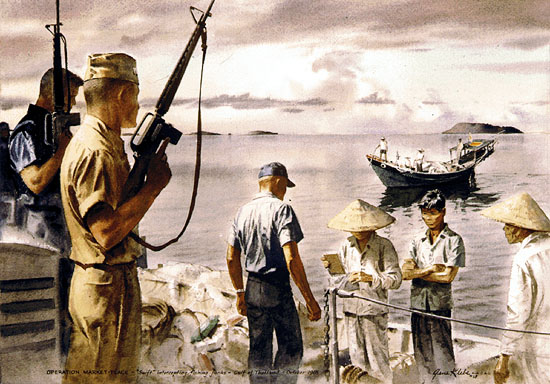
Below: Duncan Hannah, from a show last spring at JG Contemporary/James Graham & Sons, New York, a painting based on one of the photos in Antonioni's Blowup. Hannah is of the '80s appropriation generation but never got his due as a theoretical painter--he's too low key and modest in his artful (and oddly affectless) borrowings and montagings of old magazine illustrations and movie photos. Nevertheless he keeps working and showing, a kind of rootless, misunderstood existence in the uptown-style painting galleries. He has his cult, but deserves broader appreciation.
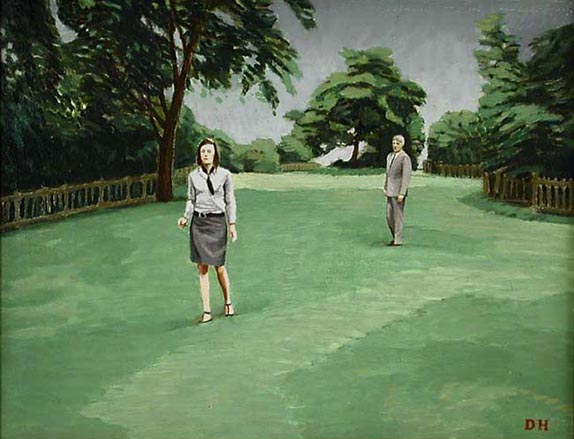
Tonight I'm going to hear jenghizkhan performing live at The Psychasthenia Society, Galapagos Art Space, 70 North 6th Street Williamsburg, Brooklyn (between Wythe and Kent). I did an interview with him here, and am curious to hear the new music he's been writing. He goes on first at 10 pm. It's free.
Tomorrow night (Thursday, December 16, 6 pm) Cory Arcangel is speaking up at Columbia U in a series called "Open Source Culture: Intellectual Property, Technology, and the Arts." Previous speakers included Joy Garnett and Jon Ippolito. Cory is strongly advised to phone this lecture in from an undisclosed location.
Everything foul about the current copyright regime is summed up in Eric Fensler doing slam-bang satirical mashups of GI Joe PSAs and getting a letter from Hasbro's lawyers telling him to remove them from his website. Hmmm, just revisited my earlier post on "Making art in the age of abusive copyright enforcement" and find that only two options for artists are still viable. Here's what I recommended six months ago to avoid the lawyer letters:
1. Stay poor. The humorless twit who sued Jeff Koons over that "string of puppies" photo would never have done it if Koons hadn't been an "art star." Very few people sue to make a point (except RIAA); it's too expensive. [Whoops, post-Fensler this now seems excessively optimistic--strike this one.]2. Record live versions of other people's songs, or song fragments, for the sole purpose of sampling them--you avoid the "master recording" fee for the sample and only have to pay the "publication" fee. Just kidding: this is actually done by the big-bucks hiphop performers, as described in the Chuck D/Hank Shocklee interview, but it sounds fake as hell--essentially having a lawyer as a creative partner.
3. Stay several steps ahead of the shysters by mutating the sounds so they're virtually untraceable. A lot of drum and bass producers do this. You don't get that bang of recognition ("Oh that's Richard Dawson in Running Man!") but the texture of the sound is yours to play with. [Dicey after the 100 Miles and Runnin case, which applies to snippets of samples. Strike this one, too.]
4. Make completely original art. No more samples, no more collage, it's back to the Modernist dictate "make it new." It's always possible you heard or saw something subconsciously that crept into your work and could get you sued, but creativity isn't just about mixing up other people's stuff. (Dumb, I know; I just put it in in case Jed Perl stumbled across the page).
